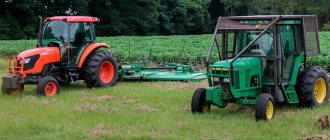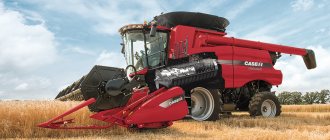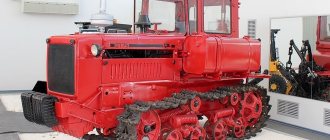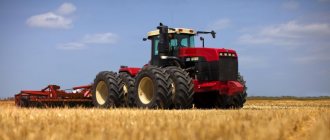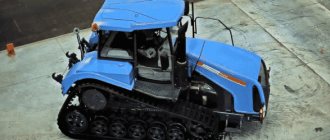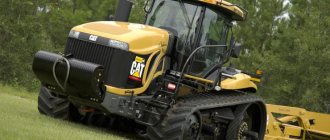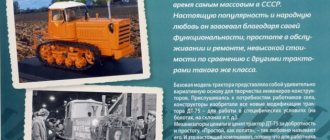Tractor "KD-35"
0
Source:
See all photos in the gallery
November 4, 1950 was noted in the chronicle of the labor exploits of Belarusian tractor builders as the day the serial production of KD-35 tractors began. The first-born of Minsk tractor builders enjoyed great and well-deserved success among field workers. The KD-35 tractors were equipped with 4-cylinder diesel engines producing 37 hp. the engine was distinguished by significant efficiency. Thus, for one hectare of plowing under average conditions, it consumed 13 kg of fuel. The tractor's fuel tank contained fuel for 10 hours of uninterrupted operation. Prototypes of the machine plowed up to 6 hectares of land in 10 hours. The tractor was not produced by the plant for long, only 9 months, until August 1951. During this time, 406 cars rolled off the assembly line. The production of diesel and starting engines for the KD-35 at the plant did not stop. They were supplied to the Lipetsk Tractor Plant. Subsequently, this engine was used on a wheeled universal row-crop tractor, on which factory designers had been working since 1948.
Good luck
On the morning of November 5, 1973, the main assembly line of MTZ was crowded - the assembly of the MTZ-80 tractor was scheduled for 10 o'clock. At the conveyor belt are the designers who designed the machine, the specialists who developed the technological process for its assembly, fitters and assemblers from the pilot production workshop, and workers from other workshops. Before the start of the shift, the teams, led by masters M.D. Sadovsky and M.V. Goncharov, held a meeting and decided to assemble the first batch without disturbing the rhythm of the main production.
At 10 o'clock in the morning the conveyor stopped for a moment. The assembler I. Ketri, to the applause of those present and the flashes of cameras, installed the semi-frame of the MTZ-80 tractor on the tape. Shop veterans L.B. Aleksandrovich and A. Lukashonok attached the motor to it. The tractor acquired more and more new units and parts. They installed the cabin on the frame.
This unusual operation for the main conveyor (it was installed on the MTZ-50 after the tractor was assembled) was clearly carried out by fitters from the pilot production workshop Dakutko, Gornostaev, Denisevich and master Golod. The first “Belarus” MTZ-80 was brought out of the workshop by the best tractor-breaker, S. N. Kononovich.
MTZ-1 and MTZ-2
0
Source:
The Belarus universal wheeled tractor was designed to work with mounted, semi-mounted and trailed agricultural machines. The design of the tractor was made in two modifications: MTZ-2 - for inter-row cultivation of low-stem crops with matching tracks of the front and rear wheels and MTZ-1 - for processing high-stem crops with close front wheels. The tractor was designed to operate on two wheels: low-pressure rubber cylinders and wheels with a rigid steel rim with spurs. The tractor had an independent power take-off shaft drive, a hydraulic system for lifting mounted implements, and was equipped with a removable adjustable tow hitch. July 18, 1949 became a significant day for all tractor manufacturers. The first Belarusian factory-designed wheeled tractor emerged from the gates of the experimental workshop. A prototype of a wheeled tractor subsequently became the basis for the creation of the MTZ-2 serial machine. In 1949, 7 prototypes were produced and underwent lengthy factory tests. A historical date for the plant’s staff was 1953, when on October 14, the assembly of the MTZ-1 and MTZ-2 tractors, created by the plant’s designers, was completed on the main conveyor. These machines determined the entire further specialization of the plant in the production of wheeled universal row-crop tractors.
×
0
Source:
KT-12 and KT-12A
0
Source:
In the spring of 1951, the MTZ team received a very important government task - to master the production of skidders, which were in great demand in the logging industry. The KT-12 gas generator tractor is a special tracked vehicle designed for forest skidding. It appeared in the USSR in the first post-war years. There were no analogues to it in any country in the world. Previously, skidding was carried out by horse-drawn vehicles, manual or mechanical winches. The KT-12 tractor was created by designers of the Kirov plant in Leningrad in collaboration with scientists from the Leningrad Forestry Academy. The KT-12 tractor was produced at the Kirov plant until 1951. Now it was necessary to establish its production at the Minsk Tractor Plant. Only three months were allotted to resolve all organizational issues. So, in the short history of its existence, MTZ had to develop a second (after the KD-35) machine, and, moreover, not of its own design. On August 15, 1951, the first batch of KT-12 skidding machines rolled off the main conveyor of the tractor assembly shop. During the production process, the tractor underwent modernization aimed at improving the performance of the machine. In a short period of time, factory designers, by changing a number of components and parts, increased the warranty period of the machine by 1.5 times.
Preparatory work
According to the national economic development plan for 1971-1975, the plant staff faced the following tasks: increase production volume, increase production efficiency and technical level of tractors, increase the production of spare parts, etc. In addition, it was necessary to begin production of a new tractor, MTZ-80 without stopping production and reducing the rate of production.
It was necessary to complete the construction of the high-rise part of the mechanical shop - MTs-5, install and debug the equipment, master the production of parts in the workshops, and organize the production of large dies at the Kharkov plant of special tools and technical equipment (SI and TO). All preparatory work was planned to be completed in September 1973 and production of new modifications of tractors began.
An operational headquarters was formed to organize the work. In 1973, they continued to increase the production capacity of the plant: they purchased 2,765 pieces of equipment, of which 2,603 were installed and put into operation. At the gearbox housing processing area, a bypass version of the LM-113 automatic line was used, and in mechanical shop No. 1, an automatic a line for refining the intermediate gear 50-1701056, an automatic line for the production of gear shift shaft 50-1702063, etc. was installed in mechanical shop No. 7.
In the same year, mechanical building No. 5 with a production area of 40 thousand square meters was completed and put into operation. m, a pedestrian crossing across Kozlova Street with a traffic capacity of 12 thousand people per hour, a centralized warehouse of the factory catering unit, the production of consumer goods was expanded by moving the workshop to new production areas, a mold manufacturing area was put into operation at the precision steel casting workshop (500 sq. . m), two Hungarian warehouses No. 44 were installed for finished components and parts (912 sq. m) and for refractory materials (1556 sq. m), a liquid glass warehouse (216 sq. m). As a result, production capacity increased by 1 thousand tractors and as of January 1, 1974 amounted to 82 thousand machines per year.
TDT-40
0
Source:
In the early 50s, the USSR Ministry of Forestry Industry stated that the KT-12A with its gas generator installation did not meet the increased requirements. Considering the disadvantages of the tractor, the ministry decided to abandon this machine altogether and raised the question of creating a new, more reliable skidder with a power of 60 hp instead. Having analyzed the situation, the designers and management of MTZ recognized the feasibility of creating a more powerful skidder, but also expressed the opinion that one powerful class of tractor for all zones in all forestry operations would be uneconomical. It was necessary to design a medium-power skidder that could be created on the basis of the KT-12A by installing a diesel engine of a Belarus wheeled tractor on it. In 1954, they developed the design of such a tractor, giving it the brand TDT-40. The tractor was intended for transporting logs directly from the cutting area. In addition to timber skidding, it was indispensable in logging and in all kinds of transport work in off-road conditions. Based on the results of operational tests in 1955, the interdepartmental commission stated that the TDT-40 tractor was very necessary for the USSR Ministry of Forestry Industry and it was advisable to establish its production in a short time. By decision of the USSR Ministry of Tractor and Agricultural Engineering, serial production of TDT-40 diesel tractors began at MTZ in May 1956. By the end of the year, their number reached 3,430. In the same year, design work was completed and the first experimental D-50 diesel engines for the promising tractor were manufactured. The new engine exceeded the power of its predecessor by 10 hp, was smaller in size and 350 kg lighter.
Middle class models
The following models are included in this section of MTZ tractors:
- models 320, 321;
- model 422;
- model 622;
- model 892;
- models 920, 921, 922;
- model 952.
In this class, models have engine power from 36 to 89 horsepower. In addition to medium-power engines, the models are also equipped with an efficient lighting system. The system's headlights are located both at the front and rear of the model.
A large number of headlights ensures comfortable operation at night.
The models use an electric starter as a starting device. The lighting system is powered by a generator.
MTZ 320
Main technical indicators of the model:
- power 36 l. With;
- maximum speed 13.37;
- mechanical transmission;
- weight 1650 kg.
MTZ 952
Main technical indicators of the model:
- power 89 l. With;
- working volume 4.75 l;
- Fuel tank capacity 130 l.
In winter, you can put snow chains on the wheels of the model. This trick will allow the tractor to cope with the task in case of heavy icing and snow piles. In addition, domestic craftsmen were able to install a homemade loader on the model on the rear linkage.
Tractor model 422
A universal and compact model that is very popular in small and medium-sized farms. Main technical characteristics:
- power 49.8 l. With;
- number of cylinders 4 pcs;
- fuel tank volume 95 l.
The model is equipped with a 65 A generator. Starting is performed using a starter, which is powered by a voltage of 12 V.
Tractor MTZ 622
The rear-wheel drive 4x4 model has the following technical characteristics:
- power 62.5 l. With;
- ground clearance 390 mm;
- fuel tank volume 95 l;
- weight 2.4 t.
The model is equipped with a comfortable cabin, which provides the driver with easy control of the tractor.
Tractor model 920
Today it is the best-selling model in the domestic agricultural market. The main parameters of the model include:
- power 81 hp;
- working volume 4.75 l;
- fuel tank volume 135 l;
- weight 4.1 t.
The model is equipped with a reliable and productive four-stroke engine.
TDT-54 and TDT -60
0
Source:
To work in the forests of the Urals, Siberia and the Far East, more powerful skidders were required than the TDT-40. The Ministry of Automotive Industry instructed the designers of the Minsk Tractor Plant to develop a project for such a tractor in conjunction with the Scientific Research Autotractor Institute (NATI) according to the technical requirements of the Ministry of Forestry Industry of the USSR. Initially, the tractor was given the brand TDT-54. To increase productivity, a D-54 diesel engine with a power of 54 hp was used. tractor DT-54 of the Kharkov Tractor Plant. After the skidder TDT-54 received the go-ahead from the state commission for mass production, a detailed analysis of each unit was carried out. As a result, it was decided to modernize most of its components. In addition, the D-54 diesel engine was boosted to 60 hp. and as a result, the tractor received a new name TDT-60. In 1956, four of its prototypes passed all control state tests under production conditions at the Vakhtansky timber industry enterprise in the Gorky region. The simultaneous production of two tractors, MTZ-2 and TDT-40, completely different in design and purpose, put the plant in a difficult position. The plant did not have the opportunity to simultaneously develop two different productions: the production of the MTZ-2 tractor, which was extremely necessary for agriculture, and the TDT-40 tractor, in which the USSR Ministry of Forestry Industry was interested. Technical and economic calculations showed that the Minsk Plant needs to specialize in the production of wheeled universal row-crop agricultural tractors. The management of the plant submitted a proposal to the ministry - to stop production of the TDT-40 tractor at MTZ, transferring it to the plant in Karelia, and the developed TDT-60 model to the Altai Tractor Plant. By decree of the USSR government of January 30, 1956, the Onega Machine-Building Plant in Petrozavodsk was transferred to the Ministry of Tractor and Agricultural Engineering of the USSR for the production of TDT-40 tractors. Before that, it was under the jurisdiction of the USSR Ministry of Forestry Industry. In 1957, without stopping the production of TDT-40 at MTZ, the development of the tractor began at the Onega Tractor Plant. In total, until 1958, MTZ produced 12,977 TDT-40 tractors. In 1957, the TDT-60 tractor was put into serial production at the Altai Tractor Plant. This was the end of the history of skidders at MTZ, where for 7 years they were produced in parallel with wheeled ones.
MTZ-5
0
Source:
Time passed, and with it the requirements for the manufactured MTZ-2 tractor grew. It had a low transport speed (13 km/h) and an insufficient number of gears. The tractor began to lag behind in terms of fuel efficiency and material consumption. It was necessary to increase the reliability and service life of the machine. Having summarized the experience of operating MTZ-2 tractors, taking into account the state and level of tractor manufacturing, the plant’s design team in 1955-1956. carried out work on a radical modernization of the machine. This made it possible not only to eliminate existing shortcomings, but also to expand the scope of application of the machine and improve technical and economic indicators. This is how new models of the Belarus tractor appeared: MTZ-5 (1956 model). MTZ-5M and MTZ-5L (samples of 1957). MTZ-5, possessing great versatility, had an independent power take-off shaft drive, a more powerful and economical engine, and a hydraulic linkage system with remote cylinders.
Addiction tests
In August - September 1973, the Belarus MTZ-80 tractor was tested at the University of Nebraska (USA). The weather was as hot as it had ever been in North America for 25 years, but even at high temperatures the engine performed well.
The first stage, on track No. 1139, lasted almost without a break until 11 o'clock at night. The next day at 5 am the MTZ-80 entered the track, which experts know well. A brake dynamometer, sensors, and burs were attached to the tractor. After this stage, after a check, another check, and a double check, even skeptics are convinced that this is not witchcraft and speak favorably of the car. The tests continued: the tractor walked lap after lap around the track without reducing the load. Even while driving, the testers changed their positions so as not to interrupt the work mode even for a second. The world-famous scientist leading the test, Professor Larsen, smiled approvingly, the testers shook hands and clapped him on the shoulder: “Very good, excellent!”
Members of the university's academic council examined the results meticulously, scrupulously, figure by figure, studied the presented report, asked about the Soviet tractors that they saw in the fields of Europe, Asia, and Africa. The tests were completed: the Soviet tractor was highly praised by foreign experts.
MTZ-5S
0
Source:
In 1959, after design improvements, production of the MTZ-5LS and MTZ-5MS tractors began. The letter “C” in the designation meant “high-speed”. Engine power was increased to 48 hp. (instead of 45) by increasing the speed to 1600 rpm (instead of 1500). The operating speed range was set within 5-10 km/h. The number of working gears in the gearbox was increased from four to five. Otherwise, there were no fundamental differences from the MTZ-5L and MTZ-5M tractors. Production of high-speed cars began in 1959.
MTZ-7
0
Source:
In 1958, the design was finalized, prototypes were made, tests were carried out, and drawings for the MTZ-7 all-terrain tractor with four driving wheels were issued in preparation for production. The first tractor design was developed using the front drive axle from the military all-terrain vehicle GAZ-67, did not have an adjustable track width of the front wheels and therefore did not provide for row-crop work. Due to the insufficient strength of the GAZ-67 bridge, the tractor did not pass the tests. The problem was solved after a GAZ-63 drive axle was installed on the tractor. The production of cabins for Belarus tractors began. The design of the removable cabin made it possible to use it on the tractor completely closed and in the form of an awning. With the use of such a cabin, the working conditions of the tractor driver have significantly improved.
MTZ-50
0
Source:
Until 1959, MTZ had the capacity to produce only 18,000 wheeled tractors of the MTZ-2 type, 6,000 TDT-40 tracked skidders and 40,000 D-40 engines. Serial production of the MTZ-5, MTZ-5M, MTZ-5L tractors was still underway, work was carried out to modernize them, and in 1956 the designers basically designed a new diesel engine for the future MTZ-50 tractor. There was great interest in the creation of a new promising row-crop tractor not only at the plant, but also in the country. The technical design of the tractor was completed in 1957 and approved by the Main Scientific Automotive and Tractor Institute. In 1958, the experimental workshop produced several prototypes of the tractor. Based on the test results, the scientific and technical council of the VO "Soyuzselkhoztekhnika" recommended the wheeled universal row-crop tractor class 1.4 "Belarus" MTZ-50 for mass production. The MTZ-50 tractor was equipped with a 55 hp diesel engine, the weight of the machine was reduced by more than 400 kg. The tractor transmission was equipped with a 9-speed gearbox, providing a speed range ranging from 1.65 to 25 km/h.
New cabin
The MTZ-80 tractor received a new cabin of a more modern design. It was developed in a special design bureau, created at the direction of the ministry with the aim of designing unified cabins for all row-crop wheeled tractors of the 0.9-1.4 class. It met domestic and foreign standards.
According to machine operators, such a cabin is no less comfortable than a car one. It protects the tractor driver from noise, vibration, precipitation, solar radiation, gas pollution, and dust. The cabin is installed on rubber shock absorbers, which reduce the transmission of vibration from the tractor frame to the cabin. The inside walls are covered with heat-, sound-insulating and sound-absorbing materials. With the help of a heating and cooling unit, you can achieve the optimal temperature in the cabin at any time of the year.
The roof and rear window open for natural ventilation. The windshield is cleaned by an electric wiper, and the rear window is cleaned by a manual wiper. Cabin glazing provides good visibility. The cabin is two-door, with handrails and steps. It has space for a thermos, a first aid kit and a clothes hanger. The driver's seat is soft, single, with torsion bar suspension and hydraulic shock absorber. The seat position is adjustable according to the height and weight of the tractor driver, as well as height and backrest tilt. You can change the firmness of the seat suspension.
All tractor controls and control instruments are conveniently located in the cab; the steering column, together with the steering wheel, can be tilted forward, and the height of the steering wheel is adjustable.
MTZ-52
0
Source:
In 1959, based on the results of state tests, the design of the MTZ-50 tractor was finalized, the necessary documentation was issued and put into preparation for production. Based on the MTZ-50 tractor, a modification of the all-terrain tractor with four driving wheels, the MTZ-52, was developed. Due to lower slipping losses, the fuel efficiency of the MTZ-52 tractor is higher at all operating limits than the MTZ-50 tractor. On November 14, 1959, the Council of Ministers of the USSR issued a resolution “On the organization of specialized production of wheeled tractors, motorcycles and engines for them at enterprises of the BSSR.” One of the points of the document stated: 2. Oblige the Council of Ministers of the BSSR to ensure: c) the production of Belarus MTZ-50 tractors starting in 1961 and MTZ-52 tractors starting in 1962, increasing the production of tractors of these brands to 75,000 units in 1965 year. The Council of the National Economy of the BSSR, by its decision of December 19, 1961, decided: 3. For a non-stop transition to a new tractor model, provide for the phased introduction of the MTZ-50 tractor, for which: - approve the transition model MTZ-50 tractor for production at MTZ for 1961-1962 PL on the chassis of the MTZ-50 tractor with a serial D-48 PL engine, boosted to 50 hp. - production of MTZ-50 tractors with the D-50 engine will begin in the fourth quarter of 1962. 1960 The plant is under reconstruction. New equipment was installed in the workshops and outdated equipment was replaced. The design of the MTZ-50 tractor was finalized, the necessary documentation was issued and put into preparation for production. Based on the MTZ-50 tractor, the plant's design team developed a modification of the high-cross-country tractor with four driving wheels MTZ-52. This machine complemented the basic model and expanded its scope of application in agricultural and transport work, especially in conditions of high soil moisture.
MTZ-50X
0
Source:
In 1963, the design development was completed and prototypes of the MTZ-50 cotton-growing tractor were produced. The tractor is designed for cultivating and harvesting cotton in a four-row machine system with a row spacing of 90 cm. The MTZ-50X tractor was fundamentally different from the MTZ-50 tractor in the design of the front axle - it had one guide wheel. The final drive assembly with additional gearboxes was also changed. All necessary tests of the tractor were completed in 1966, after which preparations began for its mass production by factory services. Production of the MTZ-50X tractor lasted eight years: from 1969 to 1977. Then production was transferred to the Tashkent Tractor Plant.
Three tracked modifications were created on the basis of the MTZ-50 tractor, and the unit unification with the MTZ-50 tractor was more than 62%. Tracked modifications were unified by 95-98%. In 1967, a version of the T-54V tracked tractor was put into production in two modifications: T-54V-S1 with a track width of 950 mm for cultivating vineyards with row spacing of 1.8 m or more, and T-54V-S2 with a track width of 85- mm for cultivating vineyards with row spacing of 1.5 m. In 1968, production of the T-54L tractor began.
MTZ-80
0
Source:
In 1966, Decree of the Council of Ministers of the USSR No. 606 was issued on the creation of a universal row-crop tractor with a power of 75-80 hp. traction class 1.4. The designers created such a tractor by modernizing the MTZ-50 tractor, assigning it the MTZ-80/82 brand. In addition to increasing the power of the serial engine, a significant number of improvements were made to the design of this tractor. In 1972, state tests of the MTZ-80/80L tractor (with electric starter and starting engine) were completed. Tests have shown that the number of machines and implements mounted with the tractor has increased to 230 items. High speed (up to 35 km/h) made it possible to use the tractor more efficiently for transport work. In 1974, the plant began serial production of the MTZ-80. The tractor was conceived as a base one, taking into account the development of a new family of unified energy-rich tractors, both wheeled and tracked. The main differences between the MTZ-80 tractor and the MTZ-50 tractor were the following: A reduction gearbox was installed in the gearbox, doubling the number of gears - 18 forward gears and 4 reverse gears; Damping springs were introduced into the clutch coupling, the design of the flywheel was changed - it became flat, which improved ventilation of the entire clutch compartment and cleaning the cavity from wear products of rubbing surfaces; A creeper has been introduced - a gear reducer, which expands the speed range of the tractor. Its use allowed the tractor to move at speeds of up to 1.3 km/h; The automatic differential lock of the rear axle has also undergone changes. Now the blocking could be carried out while the tractor was moving; A change in the design of the rear PTO drive made it possible to obtain two rotation speeds instead of one; The hydraulic suspension system has also been modernized. It is equipped with a hydraulic adhesion weight increaser (GSV), a force and position regulator. The system's load capacity has been increased to 2000 kg (instead of 1500) by increasing the pressure in the system from 130 to 160 kg/cm2; The Minsk Motor Plant was involved in modernizing the engine. The engine had two modifications with electric start. The crankshaft speed was raised to 2200 rpm.
Device
The MTZ-100 frame consists of a clutch housing, rear axle, half-frame and gearbox. The motor in the tractor is rigidly attached to the clutch housing by means of a rear plate and mounted on the front beam through a hinged support. Radiators for lubrication and cooling systems and power steering are also installed here.
The Belarus-100 transmission includes a gearbox with a creeper, a rear axle, a reduction gearbox and a clutch with brake. This model has 2 driving wheels. Aggregation with a variety of tractor machines is ensured by a separate-aggregate hydraulic system with a device position regulator and a hydraulic intensifier.
The MTZ-100 operator's cabin has a rigid frame that provides reliable protection for the driver when the machine rolls over. It is sealed and equipped with an air cooling and heating unit. "Belarus-100" has a single-seat layout, and controls and warning devices are located in front of the seat. The steering wheel tilts away from the longitudinal plane, the handrail and the 2-stage step provide convenient entry and exit from the tractor.
The engine hood is hinged on the radiator trim. A secure latch holds it in place when opening. The wings protect the operator's cabin from splashing with dirt: the rear ones are attached to the operator's cabin itself, the front ones are attached to the rotary axles. Additional weights on the front beam and rear wheels can increase the tractor's traction.
Functionally, the MTZ-100 is equipped with a side PTO, a pre-heater, a half-track and a drive pulley.
